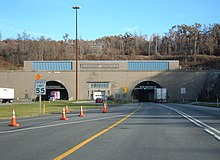Allegheny Mountain Tunnel

The tunnel’s western entrance
|
|
| Overview | |
|---|---|
| Location | Somerset County, Pennsylvania |
| Route |
|
| Operation | |
| Constructed | 1939 |
| Opened | 1940 (present-day westbound tube); 1965 (present-day eastbound tube) |
| Character | Twin-bore tunnel |
| Technical | |
| Length | 6,070 feet (1,850 m) |
| Number of lanes | 4 (two in each direction) |
| Highest elevation | 2,314 feet (705 m) |
Coordinates: 39°57′41.7″N 78°51′24.1″W / 39.961583°N 78.856694°W
The Allegheny Mountain Tunnel is a vehicular tunnel carrying the Pennsylvania Turnpike through the Allegheny Mountains. At this point, the Turnpike carries Interstates 70 and 76. When the tunnel was built, it was considered an "engineering marvel."
The tunnel was built in 1939 and is used by 11 million vehicles annually today. Throughout the 2000s, state officials attempted to implement plans to replace the tunnel, citing its age.
The original Allegheny Mountain Tunnel was built in the late 19th century for the South Pennsylvania Railroad, which was never completed. This tunnel was not used due to concerns about its structural integrity.
The eastern end of this original tunnel can be seen by parking on the service road at the turnpike's eastern portal and walking up to the area just above and a bit north of the turnpike portal. The opening is visible in the rocks just uphill. Entering this old tunnel is prohibited.
The current westbound tunnel was built in 1939 as part of the original construction for the highway. At first, this tunnel served both westbound and eastbound traffic with a single lane in each direction. The eastbound tunnel was completed in 1965 as part of an expansion and upgrade of the turnpike due to increased traffic volume. Both tunnels are approximately 6,070 feet (1,850 m) in length, making them the longest tunnels on the Pennsylvania Turnpike that are still in use (the bypassed Sideling Hill Tunnel is slightly longer, at 6,782 feet (2,067 m).).Explosives and other hazardous materials are not allowed in the tunnels. Vehicles carrying these materials must exit before the tunnel and take other roads around the tunnel. Restrictions on some hazardous materials in non-bulk form have been lifted.
...
Wikipedia
